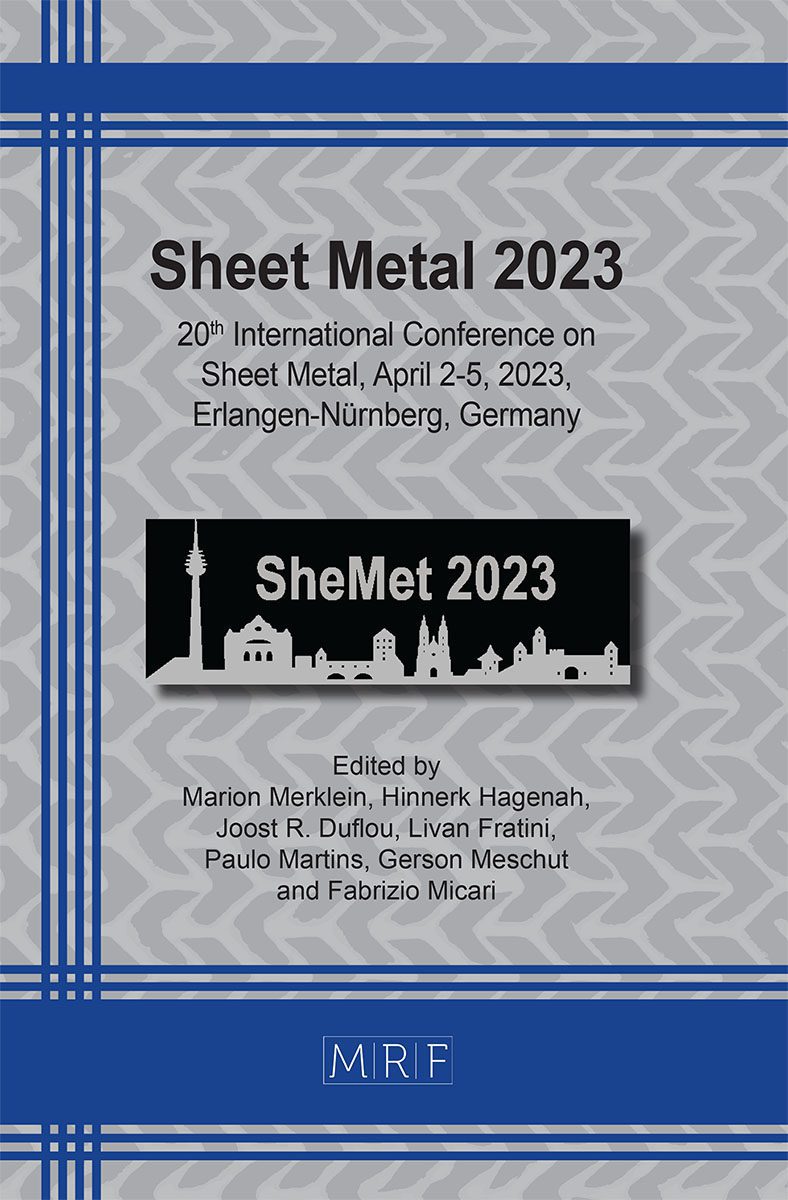High speed impact cutting of continuous fiber reinforced thermoset plastics
Fabian Dietrich, Matthias Nestler, Verena Kräusel, Matthias Kolbe
download PDFAbstract. Endless fiber-reinforced plastics are being used to an increasing extent as alternative materials for highly stressed or lightweight components instead of metallic materials. In order to achieve the geometric requirements, peripheral machining of the raw parts is necessary. Instead of the currently mainly used cutting processes, which are not suitable for clocked production, high-speed impact cutting (HSIC) was examined in the presented experiments. This technology is known as adiabatic cutting from the processing of metallic materials. Due to the high process energy which is released in a very short time resulting in high punch speed, the prevailing separation mechanism changes. Instead of bending the fibers due to the shear force the high-speed cutting experiments with a punch speed of 10 m/s lead to a brittle shearing of the glass fibers and a locally very limited heating and hence softening of the matrix material resulting in a clean surface of the cut specimen. The inter fiber breakage, meaning the separation between fibers and matrix called delamination, can be avoided or at least be sealed at the surface due to heat induced smearing of the matrix material. The resulting surface quality of the cutting edge is exceptionally good. However, the technically necessary cutting clearance leads to a jump in diameter within the cut surface.
Keywords
Fiber Reinforced Plastic, Quality, High-Speed Impact Cutting
Published online 3/17/2023, 8 pages
Copyright © 2023 by the author(s)
Published under license by Materials Research Forum LLC., Millersville PA, USA
Citation: Fabian Dietrich, Matthias Nestler, Verena Kräusel, Matthias Kolbe, High speed impact cutting of continuous fiber reinforced thermoset plastics, Materials Research Proceedings, Vol. 25, pp 315-322, 2023
DOI: https://doi.org/10.21741/9781644902417-39
The article was published as article 39 of the book Sheet Metal 2023
![]() Content from this work may be used under the terms of the Creative Commons Attribution 3.0 licence. Any further distribution of this work must maintain attribution to the author(s) and the title of the work, journal citation and DOI.
Content from this work may be used under the terms of the Creative Commons Attribution 3.0 licence. Any further distribution of this work must maintain attribution to the author(s) and the title of the work, journal citation and DOI.
References
[1] Statista, Anteil der Verkehrsträger an den weltweiten CO2-Emissionen aus der Verbrennung fossiler Brennstoffe in den Jahren 2018 und 2019, BDL (2022). [https://de.statista.com/statistik/daten/studie/317683/umfrage/verkehrsttraeger-anteil-co2-emissionen-fossile-brennstoffe/] (accessed October 11, 2022).
[2] Stephan Rosenthal, Fabian Maaß, Mike Kamaliev, Hahn Marlon, Soeren Gies, A. Erman Tekkaya, Lightweight, Automotive Components by Forming Technology, Automotive Innovation 3 (2020) 195-199. https://doi.org/10.1007/s42154-020-00103-3
[3] Carbon Fibers Technology – 9 Dimensional Assessment, Frost & Sullivan, (2014) 24
[4] F. Henning, E. Moeller, Handbuch Leichtbau, Methoden, Werkstoffe, Fertigung., 1. Aufl., Carl Hanser Verlag München, 2011. https://doi.org/10.3139/9783446428911.001
[5] Marc Kreutzbruck, Peter Fey, Wolfgang Essig, Markus Rahammer, Sebastian Joas, Thomas Erb, Igor Solodov, Faserkunststoffverbunde – Hochleistungswerkstoffe in Leichtbausystemen als eine neue Herausforderung für die ZfP, ZfP-Zeitung 151 (2016) 31-39.
[6] Yanli He, Huanan Qing, Shengguang Zhang, Dazhen Wang, Shengwei Zhu, The cutting force and defect analysis in milling of carbon fiber-reinforced polymer (CFRP) composite, The International Journal of Advanced Manufacturing Technology 93 (2017) 1829-1842. https://doi.org/10.1007/s00170-017-0613-6
[7] Sergey F. Golovashchenko, Nan Wang, Quochung Le, Trimming and sheared edge stretchability of automotive 6xxx aluminum alloys, Journal of Materials Processing Technology 264 (2019) 64–75. https://doi.org/10.1016/j.jmatprotec.2018.09.001
[8] I. Paetzold, F. Dittmann, M. Feistle, R. Golle, P. Haefele, H. Hoffmann, W. Volk, Influence of shear cutting parameters on the fatigue behavior of a dual-phase steel. IOP Conf. Series: Journal of Physics: Conf. Series 896 (2017) 012107. https://doi.org/10.1088/1742-6596/896/1/012107
[9] Sven Winter, Matthias Nestler, Elmar Galiev, Felix Hartmann, Verena Psyk, Verena Kräusel, Martin Dix, Adiabatic Blanking: Influence of Clearance, Impact Energy, and Velocity on the Blanked Surface, Journal of Manufacturing and Materials Processing 5 Nr. 2 (2021) 35. https://doi.org/10.3390/jmmp5020035
[10] Fabian Schmitz, Sven Winter, Till Clausmeyer, Martin F.-X. Wagner, A. Erman Tekkaya, Adiabatic blanking of advanced high-strength steels, CIRP Annals 69 Nr. 1 (2020) 269–272. https://doi.org/10.1016/j.cirp.2020.03.007
[11] Sabrina Moll, Untersuchung der Auswirkungen einer thermisch-oxidativen Beanspruchung auf das Emissionsverhalten von ABS und PP und der Korrelation mit dem Alterungsgrad, Friedrich-Alexander-Universität Erlangen-Nürnberg (2017) 18.
[12] Peter Sachnik, Methodik für gratfreie Schnittflächen beim Scherschneiden, TU München (2016) 16.































